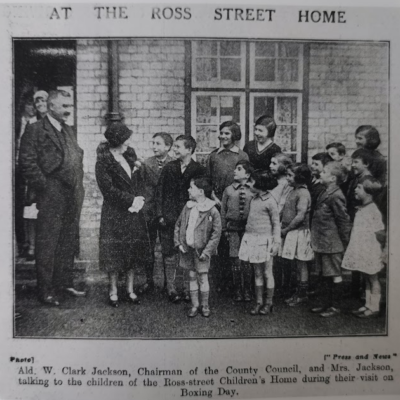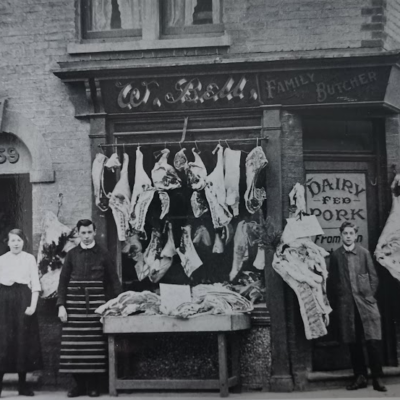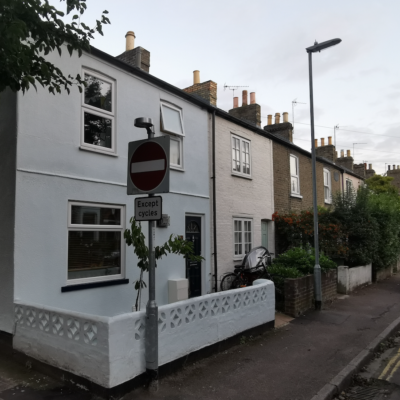Search by topic
- archaeology
- Building of Local Interest
- charity
- church
- crime
- dressmaker
- fire
- Great Eastern Railway
- Listed building
- Mapping Relief
- medieval
- oral history
- poverty
- Public House
- Rattee & Kett
- Religious House
- Roman
- scholar
- school
- Then and Now
- tudor
- women
- work
- world war one
- world war two
Search by text
60 Ross Street
History of 60 Ross Street
1913
Sidney Brown
In 2003 Elsie Holliday née Petit sent her reminiscences of life in Ross Street to the museum.
I was born at 60 Ross Street in August 1928 and lived there with my parents, elder sister and younger brother until 1938.
Our house had 2 rooms downstairs plus a back kitchen with cold water on tap. In the middle room was a coal-fired cooking range, with coal stored in a cupboard under the stairs. The kitchen had a gas cooked and a coal-fired copper in which water was heated for washing the clothes – almost invariably on a Monday. The washing was done in a rectangular wooden tub on a table in the kitchen and then put into the copper to be boiled if appropriate. Shirts, sheets etc were hand wrung to removed some of the water and then put through a large wooden-rollered mangle (wringer), which was also in the kitchen. A rope line was put up in the garden whenever clothes were to be dried and split willow ‘gipsy’ pegs held the clothes on the line, having been carried from the kitchen in an oval willow clothes basket with a handle at the top edge of two ends. A “handful” of soda crystals went into the copper to soften the water and at the end of each washday the last of the water from the copper was used to wash the kitchen stone floor and the front and back steps. No soap powders were used – just a block of creamy yellow soap and a scrubbing brush to help remove dirt from shirt collars (detachable in those days) and cuffs. There was a little wooden shelf in one corner of the wash tub to place the bar of soap when not in use. To get items out of the copper a flat stick, fairly broad at the bottom, was fashioned from a suitable piece of wood by my father. A small galvanised iron bowl with a wooden handle was used to scoop water from the copper to wash tub or bucket. Washday lunch, incidentally, was always cold meat left over from the Sunday joint (lamb or beef, pork was expensive) with mashed potatoes and pickled red cabbage, followed by rice pudding – a meal that filled and was easy to prepare and cook without too much disruption to the washing operations.
Going back to the layout of the house – there was just two bedrooms upstairs, the stairs going up from the middle room downstairs. The two girls slept in one room in a three-quarter sized iron bed, Mother and Father slept in the other room (joined by my brother in a small bed in 1930).
We had gas light downstairs (with mantles and a small tap to control the gas) but it was candles and oil (paraffin) lamps upstairs. Each bedroom had a small iron fireplace but they were never used. In winter, aluminium hot water bottles, wrapped in a piece of old blanket, were placed in beds. There was no electricity in the house.
We had a small front garden with a path leading to the front door which opened into the front (best) room where we had a couch and piano, chairs etc. and, of course, the inevitable wooden plant stand complete with aspidistra stood in the window.
Our small back garden had an entrance fro St Phillips Road and through the neighbour’s garden (no.62) and was used to grow a few flowers. A shed at the end of the garden housed father’s cycle, tools etc – the door of which can from a pub in Regent Street that was being renovated or demolished. I remember it had a decorative leaded window in the top. half with some coloured glass.
Various tradesmen called regularly but we got our meat from Mr Bell’s butcher’s shop at no.59 across the road from us, on one corner of the St Phillip’s Road/Ross Street junction. St Phillip’s Boys School was on the other side of the junction. A large lump of suet was bought for 1d and grated for use in a suet pudding or dumplings.Mr Goodrum the dairyman from Hemingford Road delivered milk in a horse-drawn milk float. The milk in churns was transferred to a delivery can that was carried from door to door and then measured into a jug. Measures (half pint, one pint etc) were open topped with a hooked handle that hooked over the edge of the can – the measure resting in the milk when the can was full.
Bread and flour were delivered by Mr Cable, the baker from Sturton Street in a horse-drawn cart, with, I believe, a rounded top and four wheels. Mother bought flour by the half quartern (2lb I think) in a plain paper bag.
I am sure that the manure left by the horses was highly prized by mother and the neighbours who always had a small shovel abd brush ready to collect up the free manure for the garden or allotment. Father had an allotment in Cromwell Road and then in Fairfax Road where he grew vegetables so that we were more or less self-sufficient in vegetables throughout the seasons. Mother bought eggs when they were plentiful in the summer/autumn (chickens tended to go off egg laying in the winter) and “put them down” for use during the winter in a large brown glazed pot with isinglass.
Groceries were collected from Warboys at 222 Mill Road.
I wanted to go to school with my sister who was at St.Phillip’s in Thoday Street. Mother managed to get me into the reception class at the age of 4. I recall that for the first part of each afternoon we had to rest on little fold-up canvas beds – this bored me! Every morning we each had a third of a pint of milk in a returnable glass bottle with a cardboard top into which we inserted a drinking straw. We also had a spoonful of malt extract while I was at St Phillip’s.We used little blackboards and chalk.
In the Junior School we were taught in Standard ! by Miss Preston (a dragon!) learned our multiplication tables by rote, wrote in exercise books, or to be precise in half books, on ruled or squared paper. We used to observe special days like Primrose Day, Empire Day and on Saints’ days we went to church in crocodiles shepherded by teachers. The toilets were outside across the playground – quite primitive by today’s standards. Our PE, or drill as it was called, was done in the playground.
In the Juniors we were taught how to sew and knit.
The classrooms were heated by coal fires which had wire-mesh guards round them – not exactly central heating!
Periodically we were given a medical and dental check-up – dental treatment was done in a specially fitted room at Sedley School – and Nurse Dora Gibbons from Stretham was the nit nurse who checked our hair for nits.
My school clothes came from Laurie McConnell’s who ran a clothing scheme. Shoes were from Freeman, Hardy and Willis but repairs (snobbing) were done by father.
Some of the girls at the school came from the Children’s Home in Ross Street, next to the entrance to the recreation ground, “The Rec.”, where we used to play. We paddled or swam in the open-air pools on Coldhams Common.
In 1938 the Autumn term started one week late, we were told that teachers were assembling gas masks.
At home we had an elderly valved wireless that ran on batteries and an accumulator that was taken to Webb’s on Mill Road for recharging. We listened mainly to ‘Uncle Mac’ and the children’s programmes and to the news. The news was read by newsreaders in BBC English so different from today’s so-called presenters.
Ross Street was a busy street with an increasing number of motor vehicles as the years went by and has happy childhood memories for me, but in 1938 we moved to a newer, large house in the area – but that’s another story.
Contribute
Do you have any information about the people or places in this article? If so, then please let us know using the Contact page or by emailing capturingcambridge@
License
This work is licensed under CC BY-NC-SA 4.0









